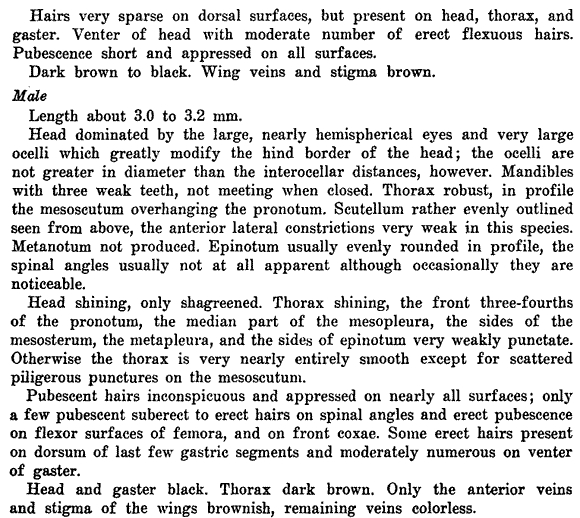- Identification
- Workers of the genus have a heart shaped gaster that is attached to the postpetiole via the dorsal surface of the first gastral segment. Antenna are 11 segmented with a 3 segmented club. Crematogaster larrea workers are similar to Crematogaster depilis. The latter has a reddish head and thorax while Crematogaster larrea are typically concolorously dark brown to black. Spines are present on the propodeum.
- Biology
- A desert species that nests in the lower stems and roots of creosote bushes (Larrea tridentata). Nests are formed from galleries left by wood boring beetles. A colony occupies only a single bush but may extend into numerous roots and stems. While not found in many areas of suitable habitat across its range it can be locally common.
- additional biology notes...
- Distribution
- Range
- Mexico and United States. Western Texas to southern Nevada and southeastern California; Mexico; Chihauhuan, Sonoran and Mohave deserts.
- Navajo Reservation Records
- Collection records being processed.
- Additional Notes
- Buren suggested the distribution of this ant may partially depend on the absence of other abundant nocturnal foraging ants from other genera. These other ants also forage on creosote bushes, potentially outcompeting and excluding Crematogaster larrea. Crematogaster depilis can also inhabit creosote bushes and both species co-occur in some areas.
- Mackay and Mackey (2002): "There is a single queen and a mean of 789 adult ants in a nest. The larval population peaks in the fall and winter, pupae are found in the spring. Males are most commonly found in the nest in June, with flights occurring during the last 2 weeks of June and during July. Foragers are active 24 hours per day with activity peaking in summer. They feed on nectar, honeydew and dead insects."
- When excited workers hold their gaster upright, above their propodeum, and wave it in the air.
- Etymology
- Ecological. Larrea is the genus name of the plant where this ant makes its nests.


- Literature
- Buren, W. F. 1968. A review of the species of Crematogaster, sensu stricto, in North America (Hymenoptera, Formicidae). Part II. Descriptions of new species. Journal of the Georgia Entomological Society. 3:91-121.
- Mackay, W. P. and E. Mackay. 2002. The ants of New Mexico (Hymenoptera: Formicidae). Edwin Mellen Press, Lewiston, NY.
- A note about these publications. The literature cited here is not meant to be an exhaustive list of papers published about this species.
Page authored by David Lubertazzi and Gary Alpert




